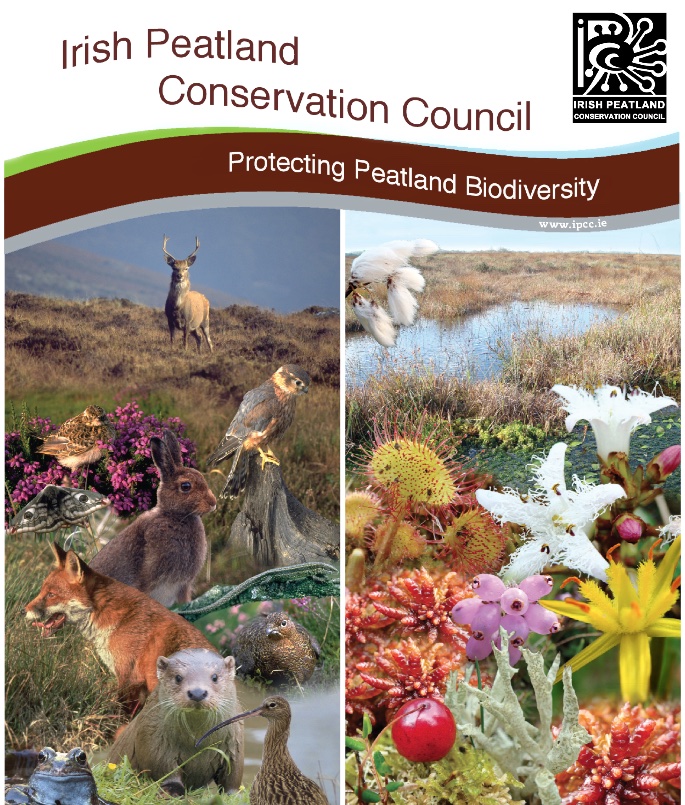Quirky facts about bogland biodiversity
16.5.2024
The boglands of Ireland are a habitat to some fascinating plants and animals that have adapted very quirky ways to live on these wet and windswept landscapes. To celebrate National Biodiversity Week 2024 the Irish Peatland Conservation Council are sharing with you some of the special and often surprising to learn quirky facts about bogland biodiversity.
There are over 20 different species of Sphagnum moss found on Irish bogs. These are known as the ‘bog builders’ and are the most important plants on bogs. They form living carpets over the surface of the bog that range in colour from green and yellow to red and brown. Sphagnum moss holds up to 20 times its own weight in water by having internal water storage cells and forming external water storage cells with other Sphagnum moss plants. Did you know during the First World War, Sphagnum moss was harvested and dried and stitched together as a wound dressing to treat injured soldiers? It was only when the last of the military hospitals closed in London in the 1920s that the use of Sphagnum moss as a wound dressing came to an end and collections of the moss from Ireland’s bogs for this purpose stopped.
Plants are normally eaten by insects. On bogs, however, the opposite happens, as insects become prey to certain plants. The leaves of the sundew sport multiple red tentacles containing glands at the tips that create a sticky trap. When an insect lands on the leaf, it gets stuck in the sticky fluid and the leaf tentacles close around it. All the nutrients in the insect’s body are digested into molecules that can be absorbed into the sundew through pores on the leaf surface. Why do they have this very special adaptation? Bogs are extremely nutrient-poor; this is due to the high water table on bogs, which limits decomposition and the associated release of nutrients.
The star-shaped flowers of bog asphodel have glowing yellow petals with orange-tipped anthers. The leaves can be described as sword-shaped and are arranged in groups of three on the stem. Living in the nutrient-poor peatland habitat, bog asphodel has formed a partnership with a nitrogen-fixing bacterium called Rhizobium. This partnership is a type of symbiotic relationship through which both bog asphodel and the Rhizobium bacterium benefit. Our atmosphere contains 78% nitrogen, but plants cannot use nitrogen in this form. However, Rhizobium bacteria can fix atmospheric nitrogen into a usable form for plants, but to achieve this it needs a host. Bog asphodel provides its roots as a host for the Rhizobium, and in return the bacterium shares its fixed nitrogen with bog asphodel.
Also known as the common lizard, the viviparous lizard is Ireland’s only native reptile. ‘Viviparous’ means ‘live birth’ and this lizard is so-named because it gives birth to live young. Did you know the viviparous lizard can drop its tail? This is a defensive feature to protect the lizard from predation allowing it to find shelter leaving its predator with only a wriggling tail for lunch! Don’t worry the tail can grow again.
Common cottongrass is one of the most well known and loved bogland plants. It produces four to five white seed heads that, at first glance, look like cotton wool and creates what can appear like a winter wonderland in June on boglands nationwide. It is the deepest rooting plant on the bog, as its roots can reach into the peat to a depth of 60cm. Did you know common cottongrass is sometimes called the ‘bog snorkeller’? Its leaves and stems contain a type of tissue called ‘aerenchyma’, which is characterised by the presence of multiple air channels. These channels allow the transport of oxygen from the aerial part of the plant (i.e. the leaves) to the roots of the plant, which are deep in the peat. Why are these deep roots so important? In the nutrient-poor waterlogged bog habitat, being able to access nutrients where no other plant can enables the common cottongrass to survive on bogs.
Boglands are home to insect eating sundews, snorkelling cottongrasses, water storing Sphagnum mosses that were once used to make dressing and lizards that drop their tail. These are not the only quirky facts about bogland biodiversity did you know it is only the male common frog that has a vocal sac that can stretch to act like resonating chambers, allowing them to sing to attract a mate or that the snipe is also known as the ‘bog bleater’, as it can use it tail feathers to make a bleating or drumming sound when in flight, which is used to proclaim territory or that a male emperor moth can detect a female up to a kilometer away using his feather-like antennae? There are many more quirky facts about bogland biodiversity to learn and you can start by visiting www.ipcc.ie.
Editors notes: The work of The Irish Peatland Conservation Council celebrating National Biodiversity Week 2024 is supported by:

